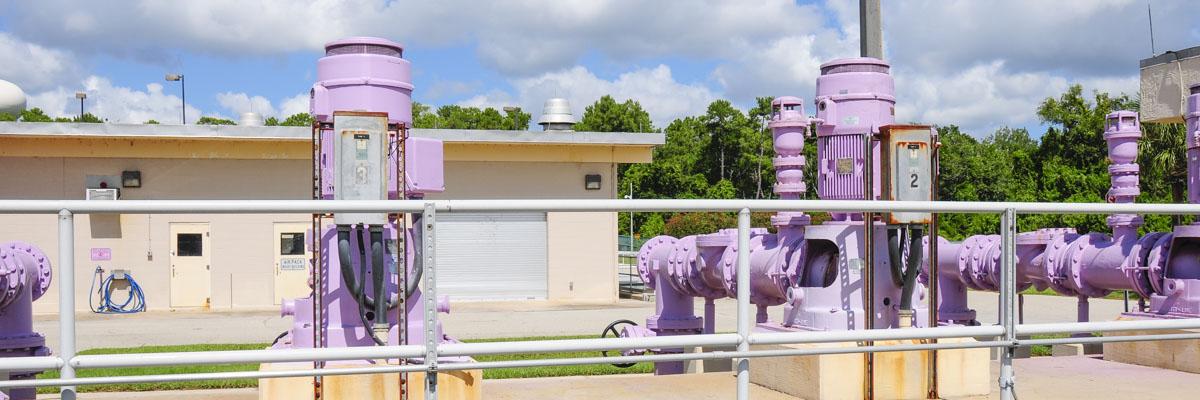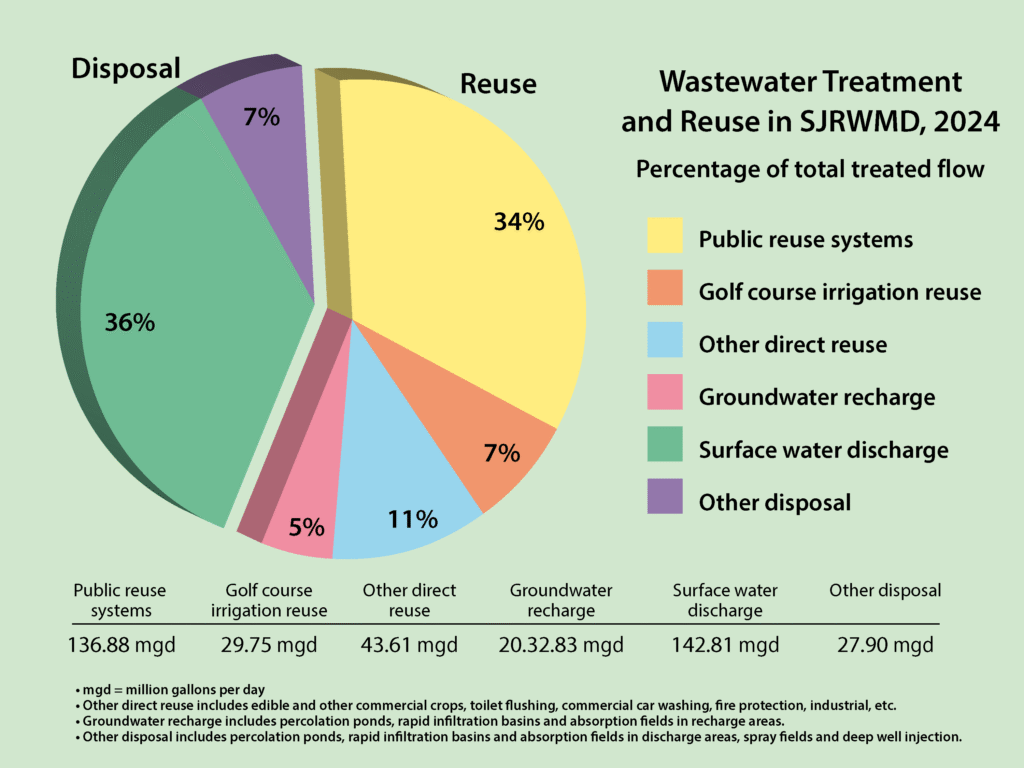Alternative water source stretches freshwater supplies, reduces pollution
Florida faces many water supply challenges. While there is no magic bullet to solving those challenges, the foundation of a sustainable water supply must be conservation, with a diversified selection of alternative sources to help stretch traditional freshwater supplies. One example is maximizing the use of reclaimed water.
Florida is leading the nation in the use of reclaimed water. But even as a national leader, Florida is only taking advantage of a fraction of its potential reuse opportunities.
In 2023, approximately 61 percent of all wastewater treatment flows within the District were reused for beneficial purposes — to replace the use of traditional freshwater supplies.
The majority of beneficial reuse currently occurs in the central Florida area, but other areas of the District are planning expansions of their systems.
Resources
Challenges
Providing high-quality drinking water to Florida’s growing population has become more challenging and costly in recent years.
At the same time, wastewater management has become increasingly difficult because of environmental concerns.
Traditionally, the majority of drinking water for the 18-county population in the District has come either from private wells or public supply utility wellfields drilled into the Floridan aquifer system. In many areas of the District, groundwater (aquifer system) cannot support all future demands without causing unacceptable impacts to the environment (such as the reduction of spring flows or the drying of wetlands) and the District will not allow such impacts to occur.
Meeting projected future water needs will require continued water conservation programs and innovative management strategies, such as the development of alternative water sources. Many non-potable (nondrinking) water needs can be met by reclaimed water.
Although reclaimed water offers significant potential as an alternative water supply source, there is typically too much of it available during periods of high rainfall and not enough available to meet demands during low rainfall periods.
Wastewater is produced constantly throughout the year, with no dramatic seasonal highs or lows. But irrigation, which is the most common use for reclaimed water, fluctuates seasonally, with demand being typically higher from March through July. Thus, storage of unused reclaimed water during times of excess for use during times of peak demands is desirable. Reclaimed water reservoirs or storage tanks are necessary to provide this storage.
In addition, reclamation facilities and reuse sites are not necessarily located near one another, so reclaimed water must be transported. Transmission lines and facilities, which can be expensive to construct or disruptive, (particularly in older or built-out areas) are necessary to accomplish this.
Solutions
By using reclaimed water, communities can conserve traditional freshwater supplies and provide an environmentally responsible alternative to disposal of wastewater.
Reclaimed water can be safely used for a wide variety of purposes, including landscape irrigation for golf courses, parks, highway medians, playgrounds and residential properties. Reclaimed water also is used for agricultural irrigation; decorative ponds and fountains; groundwater recharge; industrial uses such as cooling; fire protection; and wetlands creation, restoration and enhancement.
Click each link below to see how wastewater is reused in these counties:
Frequently asked questions
Reclaimed water is wastewater that has been thoroughly treated to remove harmful organisms and substances, such as bacteria, viruses and heavy metals, so it can be reused.
Water reuse involves taking what was once wastewater, treating and disinfecting it, then using the resulting high-quality reclaimed water for a beneficial use, such as irrigation for golf courses, parks, highway medians, playgrounds and residential properties. The degree of treatment depends on what purpose the water will serve. Irrigation is the most common type of reuse.
Florida utilities began using reclaimed water in the 1970s. Since then, it has become a major component of water resource management by local governments and utilities within the state of Florida and the District.
Redirecting the disposal of wastewater and recognizing it as a commodity — reclaimed water — will not only improve the St. Johns River’s ecological health by removing excess nutrients, but it will also protect and further extend Florida’s water supply. Using reclaimed water saves fresh drinkable water for use in homes and businesses; provides a safe, environmentally responsible alternative to wastewater disposal; delays the need to develop alternative drinking water supplies and can reduce the need for fertilizer.
The water is clear, odorless and safe, but usable for only nondrinking or nonpotable water purposes in Florida.
Reclaimed water is permitted for many nonpotable uses, including landscape, commercial and agricultural irrigation, groundwater recharge; industrial uses such as cooling, process or wash waters; fire protection; wetlands creation; restoration and enhancement. To assure safety for other uses, reclaimed water that is used in areas where people may come in contact with it, such as for landscape irrigation, must meet drinking water standards for pathogens, but it usually contains impurities that keep it from meeting other drinking water standards.
Reclaimed water facilities are constantly monitored to ensure that only high-quality reclaimed water is distributed. The Florida Department of Environmental Protection’s rules govern the reuse of reclaimed water to protect public health and environmental quality.
The use of reclaimed water for raising edible crops by the general public is not permitted. However, reclaimed water is used in commercial agricultural operations including irrigation of edible food crops such as citrus, corn and soybeans. Millions of people eat or drink juice from Florida oranges grown with reclaimed water. There are no known cases of disease resulting from eating fruit or vegetables grown with reclaimed water that meets Florida’s standards. To assure additional safety, Florida regulations allow reclaimed water to be used to irrigate only food crops that will be peeled, skinned, cooked, or thermally processed before consumption. This avoids the possibility of the reclaimed water coming in direct contact with a food product that could harbor a live pathogen.
It is the most environmentally beneficial solution to reduce nutrient loading, to help offset future water supply needs and to provide for long-term growth in the area. High-quality groundwater supplies may not be able to meet all future needs. At the same time, it has become more difficult to dispose of increasing quantities of treated wastewater in an environmentally sound manner. Reusing reclaimed water addresses both of these problems.
It is necessary to provide public education on appropriate uses of reclaimed water. Water users must understand that reclaimed water cannot be connected to potable water plumbing systems and should not be consumed. Reclaimed water service providers also need to monitor their systems to ensure that there is no cross connection with their potable water systems. And, as with high-quality groundwater, reclaimed water supplies are limited. So even when using reclaimed water, it is important to practice conservation measures such as planting water-efficient landscapes and irrigating appropriately.



